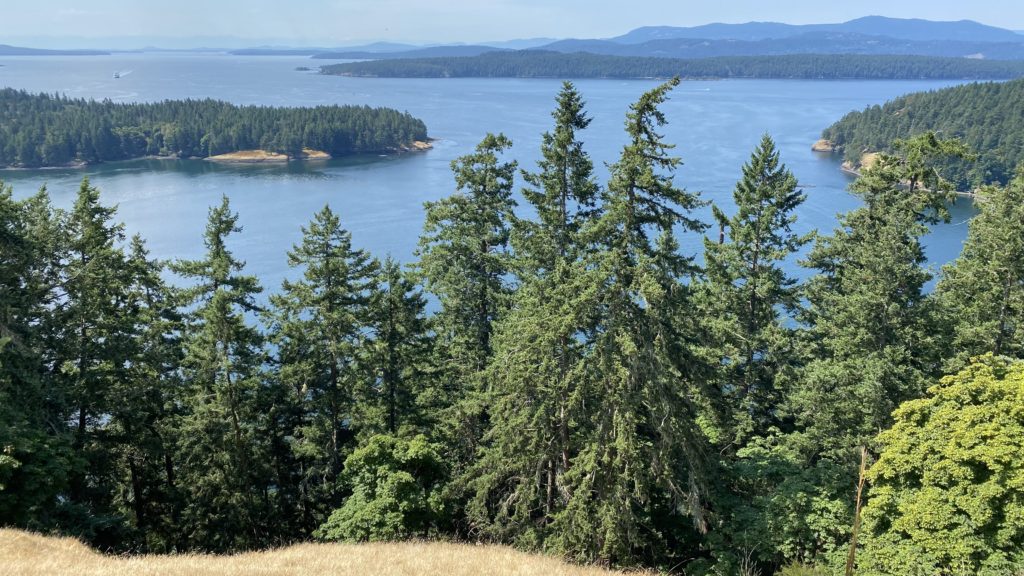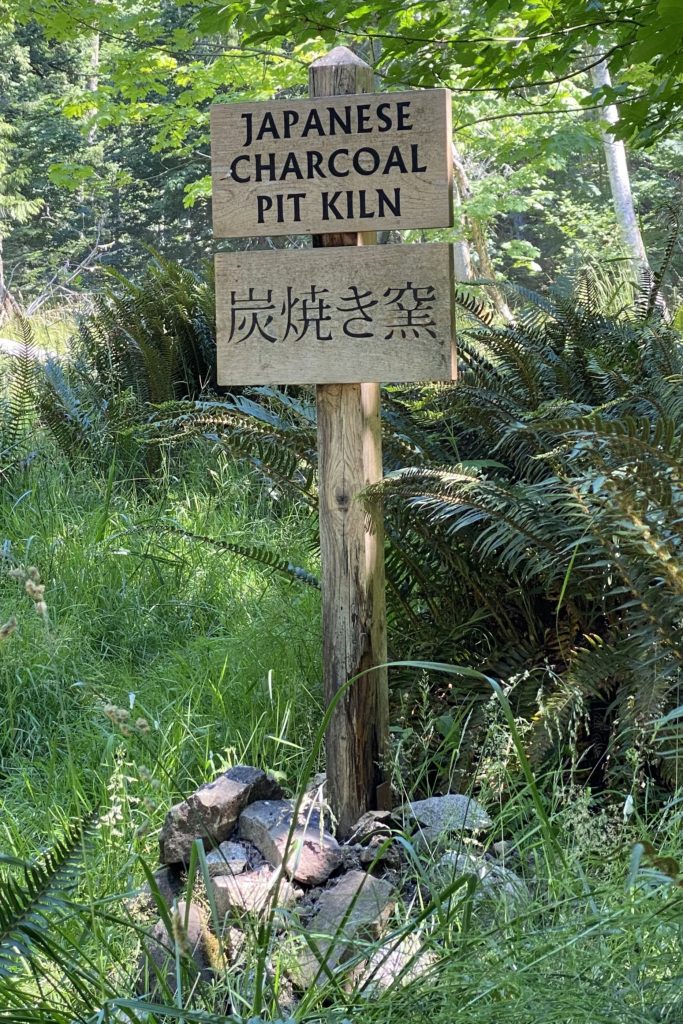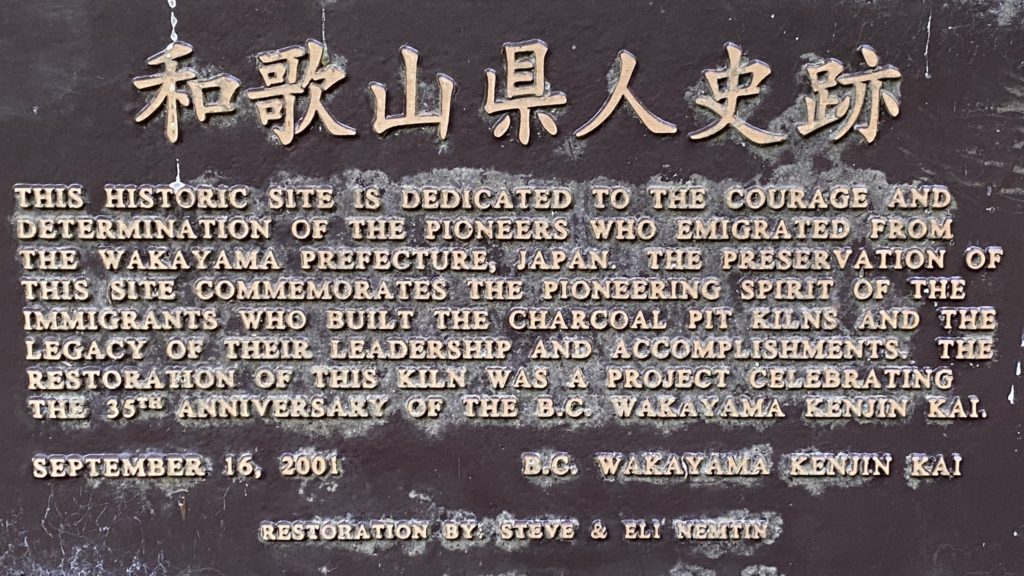
I figured I’d better start with a graphic in order to explain my title. I have never heard anyone here on the island refer to Galiano’s shape as a long, crooked male member. However, I don’t really see how one can miss the obvious. Maybe this says something about me and John that we immediately viewed it this way. In fact, I was talking about our being on the testicles and it took John’s veterinarian friend, Rick, to correct me and point out that we are actually on the scrotum, not the testicles, which are inside the scrotum. I never was very good at biology. Thanks Rick!
Our house is right on Georgeson Bay on Active Pass in the little bay at the bottom of the graphic. Mount Galiano is next to us and the Bluffs protected area is behind our house so we have some of the best hiking on the island at our doorstep. It’s takes about 20 minutes to get to the top of the Bluffs (and more like an hour to the top of Mt. Galiano). Both have incredible views and Moose and I go up to the top of the Bluffs several times a week.

On my way down from one of my earliest outings, I noticed a wood sign for Japanese Charcoal Pit Kiln. How strange, I thought, why would there be Japanese kiln on Galiano island?

Following the path, I came upon a fascinating historical location hidden in the woods (see Moose below inside the restored kiln). It turns out that back in 1982, one of my neighbors, Steve Nemtin, who I just met on Monday, was walking in the forest and fell into a large hole. An avocational archaeologist, he later learned that it was the remnants of a pit kiln created and used by Japanese Canadians for making charcoal prior to WWII. This mishap led to the discovery of fourteen more charcoal kilns in the southern Gulf Islands including a total of five on Galiano, the restoration of three, and the formation of the Historical Charcoal Kilns of the Southern Gulf Islands Project that resulted in a book published in 2017, Island Forest Embers, that I just purchased and read.

When I came across the kiln in the woods, one of the three that have been restored, it piqued my interest in this part of the island’s history. I learned that there was a significant Japanese population on the Gulf Islands, as well as on Vancouver Island and around the Fraser River delta near Vancouver in the late 1800’s and early 1900’s.

The Japanese immigrants had to contend with anti-Asian discrimination that made it increasingly difficult for them to fish and earn a living. On Galiano, many worked in the fish saltery on the Northern end of the island. Charcoal was used for domestic cooking and heating , in blacksmithing, in the manufacture of explosives and soap, and in BC’s salmon canning industry. Given the high demand for charcoal, the Japanese Canadians, who already had the knowledge of how to make charcoal, were able to supplement their incomes by building and operating the kilns and then selling the charcoal both on and off the island. Right next to our house, the first government dock on Galiano was built (no longer there) and the charcoal from the nearby kiln was loaded onto boats to be taken up island.
Tragically, the end of this story occurred on April 21, 1942 when every person of Japanese descent was rounded up (23,000 in all) and sent to internment camps in the interior of the province, usually losing their possessions and homes, frequently separated from their families, and generally treated similarly to Japanese Americans at the same time. They were even forbidden from returning to BC after the war until those restrictions were finally lifted in 1949. It is now seen as the biggest human rights violation in Canadian history. And thus, there are no records of who exactly built the kilns here on Galiano, that history being totally lost. But at least we now know the story, if not the names of the individuals, partly thanks to my neighbor Steve falling in that hole.
So, as you can tell, I’ve started to discover some of the history of what has taken place here on the scrotum and I’m sure there will be more to come. 😉
Ohhhmy gosh! Your renaming of the island and where you live.. in biological detail was hilarious! Fabulous way to kickstart my day:)
Thank you!
The Japanese…the other end of the spectrum— such a sad story.
Great to hear about your new home.
Too funny April thanks for the acknowledgment
I think 😘
Internment was such a sad and shameful part of our history. I had no idea that Canadians did the same thing.
Galiano saved the pit cairns and thus preserved the history. U. s . Bans George takai’s book on internment…
You walk away with the award for World’s Most Clickable Title!
It’s amazing what a scrotum can hold!
very interesting to hear more about your life there and super fascinating about the Japanese Canadians and the fact that they were interned just as the Americans. I wonder if there was some discussion between the two countries?
Funny 😊!!!Cant wait for you to discover the Labia Majora now !
Ashok
Geography, history, and biology- you have covered it all April! Well done- quite entertaining and insightful. Keep the blogs coming! Very enjoyable reading.
Willa would find this title very funny right now, going into 5th grade. Though we did not think of this nickname for the island when we were there.